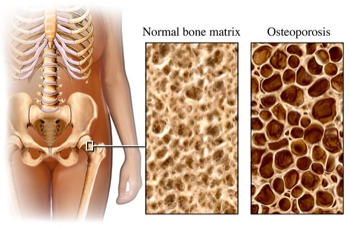Myths and Facts about osteoporosis
on- 2015-09-19 12:42:30
- 0
- 4334

Osteoporosis is a famous medical condition known by the weakening of bones and their thinning, which is a serious disease that affects a significant number of people, mostly after the age of fifty, especially in women. It is a disease that exposes bones to breaking easily and causes some physical disabilities in some cases, due to the wide spread of the disease these days as a result of the wrong nutrition in which calcium is reduced significantly, and as a result of not exercising. A lot of false rumors and myths about the complications of osteoporosis spread and we are trying to correct them in the following lines.
Myths and Facts about osteoporosis:
- Osteoporosis is a symptom of aging: due to the vulnerability of the elderly to fractures more than others, but it is not necessary for the osteoporosis patient to have fractures, as fractures can be prevented by many health options such as obtaining adequate intake of calcium and vitamin D, and practicing aerobics or walking.
- Osteoporosis affects women only: it is certain that women are more susceptible to osteoporosis, however one out of every five men in America who are above the age of fifty has osteoporosis compared to a woman out of three women, which means that men in the younger age are more susceptible to of fractures than women .
- Disease affects the elderly only: it is scientifically known that 90% of bone mass is composed at the age of eighteen among girls, and in the age of twenty among youth, which is an important stage for building strong bones of considerable intensity that will protect the person as he ages, and by the following correct eating habits that are sufficient to cope with health problems in the elderly.
- Fractures are the only complications of osteoporosis: The osteoporosis is serious and fatal in some cases, as it could lead to hip fractures. The percentage of the deceased after 6-12 month of fracture is 25%. As the hip replacement surgery may result in many problems such as irregular heartbeat, anesthesia complications, pneumonia, heart attack and infection, and the proportion of women exposed to the risk of death due to hip fractures is equal to that of women with breast cancer.
- Fractures occur as a result of falling only: fractures occur in osteoporosis as a result of the weakness of the bones, however some people may have spontaneous fractures such as pressure on the bones resulting from leaning on a solid body, or due to the fatigue fracture such as the fracture resulting from merely walking.
- Osteoporosis patient feels the weakness of bones: the patient cannot feel osteoporosis or that he has it until he becomes broken, he does not feel the weakness of his bones or lack of their density, so osteoporosis is known as a silent disease that can be detected only through a special examination for measuring bone density.
- Bones cannot be built and strengthened after osteoporosis: it is possible to re-build bones using medications that works on increasing bone density by simple rates when used for a long period which may extend to four years, as the bone density improves but does not return to the normal level before the disease.
Osteoporosis largely affects the patient's life with a degree that varies from one person to another depending on the complications that results from it, and that may end up by entering the hospital several times or exposure to the death, that requires appropriate prevention and submission for treatment to reduce these complications.



